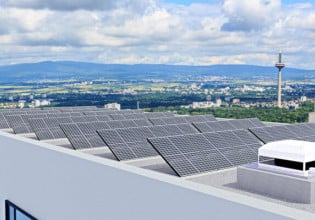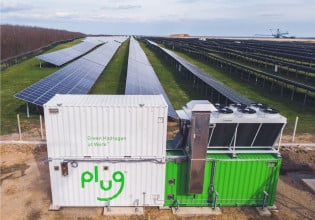DOE Awards $347M for Grid Resilience, Energy Codes, Solar Manufacturing & Wind Turbine Recycling
The U.S. Department of Energy recently announced four funding programs for increased grid modernization, energy code updates, solar manufacturing, and wind turbine recycling projects.
The U.S. Department of Energy (DOE) regularly announces new funding opportunities and grant selections for the renewable energy sector. The four programs covered in this roundup total $347 million and target grid resilience, solar component manufacturing and dual-use photovoltaics, updates to building energy codes, and recycling for wind turbine components.
Wind turbines and solar panels during the day. Image used courtesy of Pexels/Kindel Media
These are among the latest funding programs the DOE has announced in recent months. The agency oversees the hundreds of billions in clean energy investments allocated through Congress.
$207M for Grid Resilience and Modernization
DOE has revealed the third cohort of its Grid Resilience State and Tribal Formula Grant program, funded through the Bipartisan Infrastructure Law enacted in 2021. Nine states and three Tribal nations will receive $207.6 million to help modernize their electric grids in the nationwide transition to renewable energy resources. The announcement says the program will distribute $2.3 billion over the next five years to states and tribes.
California is the top beneficiary, receiving the largest award of $67.5 million. It will use the funding to lower the frequency and duration of power outages, a prevalent issue as heatwaves drive demand higher than the grid can handle. The state’s electricity is heavily weighted towards renewables, with intermittent solar energy supplying about one-fourth of its electricity. It lacks sufficient energy storage capacity to pick up the shortfall.
Last summer, California’s electricity demand climbed to a record 52 gigawatts (GW) amid triple-digit temperatures. Power usage adjustments from consumers helped avoid rolling blackouts in that case. The state is now drawing federal funds to boost its resilience and expand renewable energy deployment to combat the effects of heatwaves, wildfires, and other emergencies. The California Public Utilities Commission reached 5.6 GW of battery storage capacity as of July 2023, up from 3.86 GW in late June 2022 and 500 megawatts (MW) in 2020.
Texas received the second-largest grant of $60.6 million, which it will use to identify gaps in grid resilience and minimize disruption via weatherization and modeling systems, vegetation, and fuel load management. It also aims to ensure the measures can be operated/maintained without contractor support, boosting the skilled workforce.
Other awardees with $10 million or more in grant funding include the following:
- Oregon will use its $19.9 million share to refine grid resilience program objectives, metrics, and criteria to serve disadvantaged communities and nine Tribes in the state.
- Michigan got $14.9 million for last-mile delivery solutions for low-income customers and mitigating severe weather disruption on power facilities. The funds will also serve non-wired alternative projects.
- Kansas will receive $13.3 million to promote grid equity across rural and underserved communities.
- Minnesota gets $11.9 million to pursue projects with benefits aligning with the federal Justice40 initiative serving disadvantaged communities.
- Kentucky’s $11.1 million will help improve the resilience and reliability of the state’s electric grid and critical infrastructure. The funds will also expand local workforce capacity and support projects with small entities and state facilities that typically take the lead in natural disasters.
$90M for Building Code Programs
The DOE awarded $90 million for 27 projects in 26 states focused on energy efficiency standards for buildings. The recipients will use the funding for technical assistance to update state and local building codes. The DOE is incentivizing the adoption/implementation of “model energy codes,” analyzing energy and cost savings with code updates and improvements and ensuring compliance. A federal impact analysis estimates that model energy codes for commercial and residential buildings will save $138 billion on Americans’ utility bills and avoid 900 million metric tons of carbon dioxide emissions from 2010 to 2040.
Estimated impact of building energy codes in the U.S. from 2010 to 2040. Image used courtesy of Pacific Northwest National Laboratory (page 6)
The DOE announcement claims that homes built according to today’s energy codes are 40% more efficient than those built 15 years ago. Still, the country’s 130 million commercial and residential buildings are responsible for 35% of carbon emissions. Energy codes establish minimum efficiency standards in new and renovated buildings, but two out of three communities in the U.S. haven’t adopted the latest codes. As such, the new funding will support these updates and implementation with workforce training on the latest building codes, data collection, and research, and expanded support for compliance and enforcement.
The awardees include energy offices/commissions, cities, code councils, private companies, and nonprofits. The largest award ($9.6 million) went to Washington, D.C.’s American Council for an Energy-Efficient Economy, which will establish a nationwide network to support states and local governments in implementing updated building energy codes. The Metropolitan Energy Center in Missouri received $6.8 million to leverage its 30 regional/state/community partner network to expand the energy code workforce in rural and disadvantaged communities across the state and Kansas.
Minneapolis’s Center for Energy and Environment will use its $5.3 million grant to provide technical resources for code adoption and conduct compliance activities, including outreach, training, and tool development. Washington D.C.’s Institute for Market Transformation got $5 million to help jurisdictions design and implement building performance standards and policies focused on decarbonizing existing buildings.
The new funding is part of a Bipartisan Infrastructure Law-supported program that appropriates $225 million to implement updated building energy codes from 2022 to 2026.
$45M for Silicon Solar Manufacturing and Dual-Use Tech
DOE announced $45 million for solar component manufacturing projects to boost the domestic supply chain and better compete with China and other global market-leading competitors. The program is partially funded by $18 million from the Bipartisan Infrastructure Law. In addition, it will support emerging dual-use solar technologies, a market that integrates solar energy into existing landscapes.
Up to 12 projects will be selected for producing polysilicon, silicon ingots and wafers, solar cells, module components and glass, and manufacturing equipment. Additional projects will focus on new markets in the dual-use PV sector. Examples include building- and vehicle-integrated photovoltaics (PV), agrivoltaics, and floating PV. Concept papers are due on Sept. 27.
The announcement is one of 40-plus solar supply chain investments announced over the last year.
$5.1M for Wind Turbine Recycling
The DOE’s $5.1 million Wind Turbine Materials Recycling Prize, funded through the Bipartisan Infrastructure Law, aims to recycle two key wind turbine materials: fiber-reinforced composites and rare earth elements. DOE noted that 85-90% of wind turbine mass contains materials that can be recycled. However, most unrecycled materials are made of carbon fiber and fiberglass, found in blades, nacelle covers, and hubs linking blades to turbines. Like many industries, wind energy relies on critical minerals and rare earth elements such as neodymium and dysprosium magnets used in generators, which have virtually no domestic recycling options at a large scale.
In the first phase, DOE expects to award $75,000 in cash prizes to up to 20 applicants focusing on wind turbine recycling. The first of two phases, dubbed “Initiate!,” will accept applications until Sept. 29. It targets private organizations, non-federal entities, universities, and individuals.
Overview of the timeline and two phases of the Wind Turbine Materials Recycling Prize. Image used courtesy of DOE
In the second phase, up to six teams will be selected to receive $500,000 cash prizes and vouchers valued at $100,000 to collaborate with the DOE’s national laboratories.









